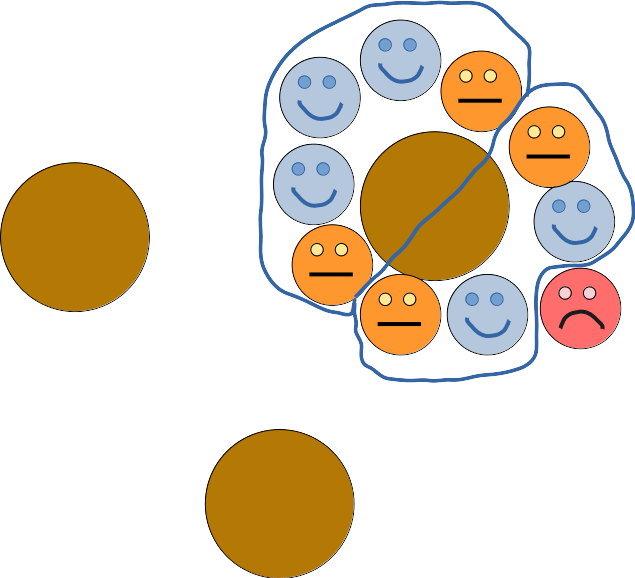This is part 2 of “The Round Table Manifesto”. Check part 1 out here.
The wonder of round tables
The problematic situations described in part 1 can be avoided by adopting round tables, with a max of 5-7 people seated around them. Circular seating means no three-in-a-row. No three-in-a-row means that no one falls between the cracks. The explicit participant limit avoids the observer pattern & subdividing into noisy neighbouring groups.
Unfortunately, there are reasons why people prefer long tables. Round tables require skill and maturity to function well. The rest of this text is centered around adoption problems.
Round table problems - and how to solve them
Round tables & incremental filling
You enter the lunchroom at work. There are three round tables. Two of the tables are empty. Seated around the third table is 7 people. You don’t want to sit by yourself. What do you do?
Bad option: Oversaturating the table
One option is to ask the people sitting around the table if you can bring a chair over. This solves the immediate problem of not having to sit alone, but it also degrades the conversation at the table.
Repeat this scenario a few times, and you will be stuck with 7-10 people around the table. In practice, you will be 2+ groups of people sitting around a single table, with multiple empty tables around.
Bad option 2: Creating a long table
I’d seen cases where people start dragging a table over, joining 2+ round tables into a long table-esque monstrosity. In theory, this is a good way to demonstrate that you are one big group where everyone likes each other. In practice, you’ve reinvented the long table with all its problems.
Better option: Doing the Split
A better way is to split up the group whenever it grows too big. This is best initiated by one of the people sitting around the table. The table person simply asks the new person “hey, do you want company?”, joining the new person around one of the empty tables if the new person wants company.
This is a norm worth reinforcing. At my workplace, we’re quite good at asking this, and that works out fine. But remember, sometimes people want to sit alone. If they do, please let them.
Explicitly splitting groups like this might cause mild social anxiety, but trust me, it’s way better than stumbling into a suboptimal constellation.
Summary
Groups split into sub-groups when they reach 5-7 people. By moving the sub-groups into separate round tables, we reach optimal hangout quality.
Long tables don’t require explicit splitting of the group. This is a problem, because the implicit splits are often suboptimal, causing people to get left out and/or impinged upon.
Round tables require explicit splitting of the group, best initiated by someone already comfortably seated.
Action plan
Tell people about the fact that group conversations stop working at 5-7 participants.
Tell people how group max capacity interacts with long tables, creating unpleasant situations.
Whenever you can, advocate for replacing long tables with smaller round tables seating a maximum of 5-7 people.
If you see someone left out, ask them if they want company. If they do, move over and sit down with them at an empty table.
Make others do (3) by enforcing it as a norm in your social context.







